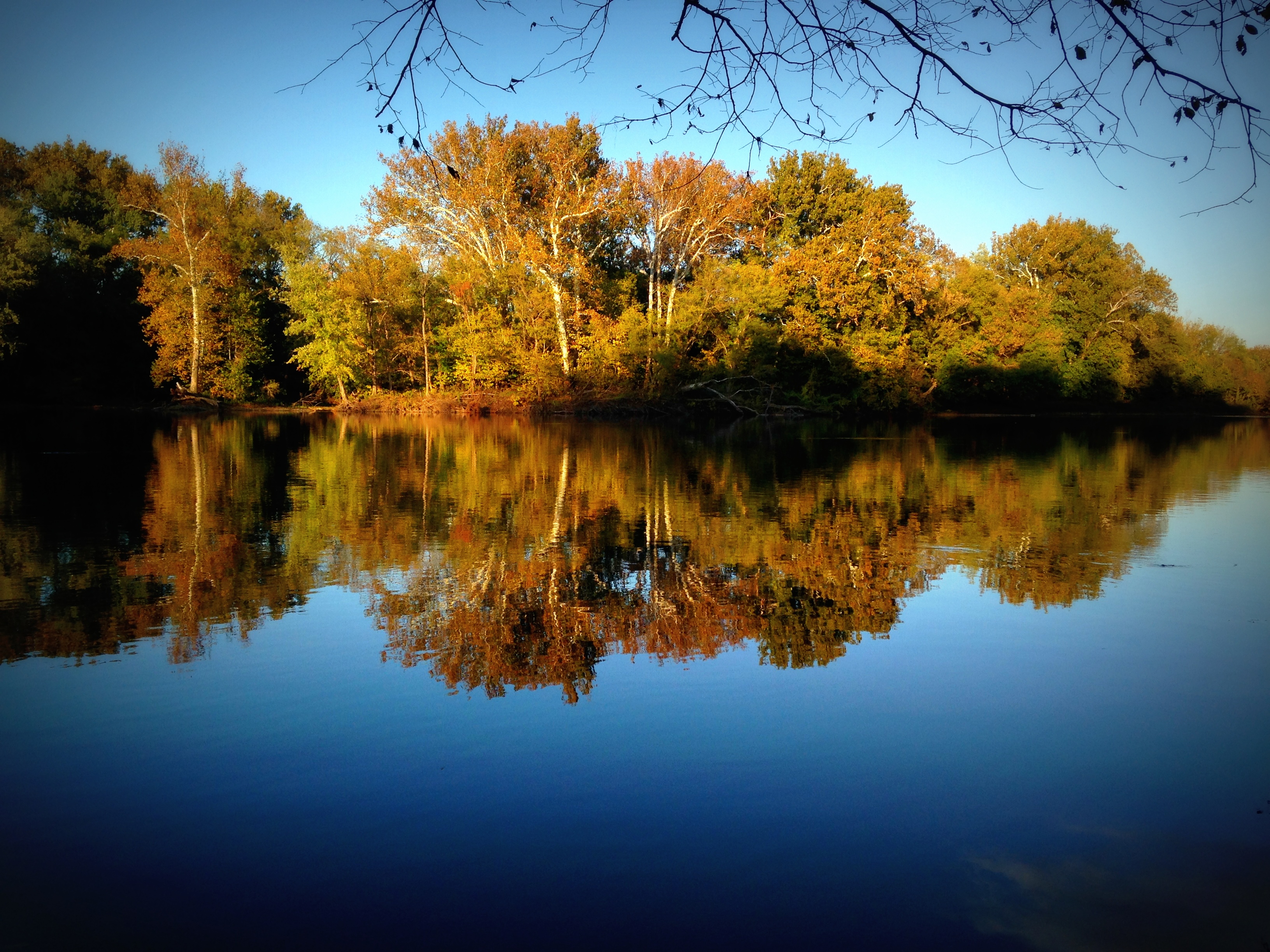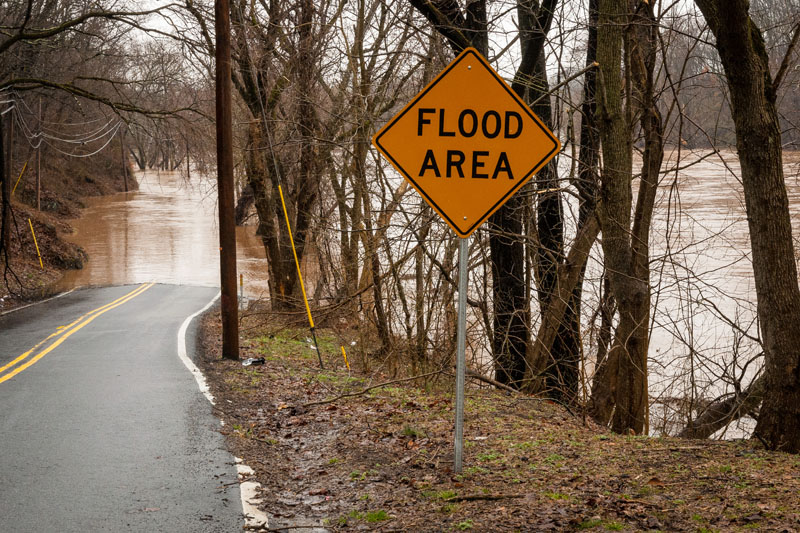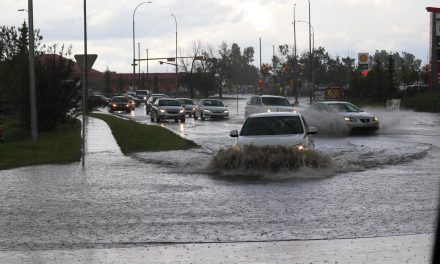On April 21, the U.S. Environmental Protection Agency (EPA) and U.S. Army Corps of Engineers (Corps) opened the proposed Waters of the U.S. rule to comment, and since then, EPA has said it expects an unprecedented number of comments. The proposed rule seeks “to provide the intended level of certainty and predictability, and minimize the number of case-specific determinations” about whether various waters and wetlands are jurisdictional under the Clean Water Act.
According to EPA and the Corps, the rule would subject approximately 3% more U.S. waters to Clean Water Act jurisdiction and generate as much as $514 million annually in public benefits, such as reduced flooding and groundwater recharge. However, analyses performed by other groups contradict both the number of waters affected and the cost of the proposed rule. With comments due Nov. 14, this article examines points of intersection between the proposed rule and the stormwater sector with viewpoints from various stakeholders across the country.
Introduction
G. Tracy Mehan, George Mason University School of Law
The proposed rule, “Definition of ‘Waters of the United States’ Under the Clean Water Act,” has generated a firestorm of controversy as EPA struggles to reconcile 21st century ecological science, with its core concept of connectivity, and the Clean Water Act’s 19th century paradigm of navigability, which is the anchor of the act’s jurisdiction and scope. Congress has declined to resolve this tension and even the Supreme Court has contributed to the confusion.
The recent case, Rapanos v. United States, resulted in a fractured 4-1-4 decision on whether certain wetlands are, or are not, jurisdictional. However, Justice Kennedy’s opinion, the “1,” along with four dissenters, elevated the concept of “significant nexus” as a central holding. The EPA and the Corps have seized upon this concept with enthusiasm in their proposed rule. “Significant nexus” is not a scientific term, say the agencies, but it is a “touchstone” for Clean Water Act jurisdiction and is central to the entire rule. The term refers to the connectivity and influence of waterbodies as a determining factor in whether they are considered jurisdictional.
Significant nexus is a determination to be made by EPA and the Corps under the law in light of applicable science. Yet, EPA does not offer an affirmative definition of “significant.” In the 2001 Supreme Court case, Solid Waste Agency of Northern Cook County (SWANCC) v. U.S. Army Corps of Engineers, the court ruled that the agencies have no jurisdiction over non-navigable, isolated, and intrastate waters. The significant nexus concept now appears to be the vehicle by which the agencies are hoping to reclaim or restore jurisdictional status to those waters currently beyond the reach of the Clean Water Act. SWANCC was not overruled in Rapanos, but the agencies do not seem recognize it to any significant degree in this rulemaking, utilizing the “significant nexus” analysis going forward.
In the proposed rule, EPA and the Corps offer a host of new definitions for “tributaries,” “other waters,” and more. Like “significant nexus” these terms are abstract and contingent on variable field conditions. It will be incumbent on all interested parties to offer concrete and focused comments on the proposed rule to ensure that it maintains a not insignificant nexus to real world conditions.
The Rule’s New Tributary Definition is Problematic for MS4 Permitees
Scott Taylor, Michael Baker International
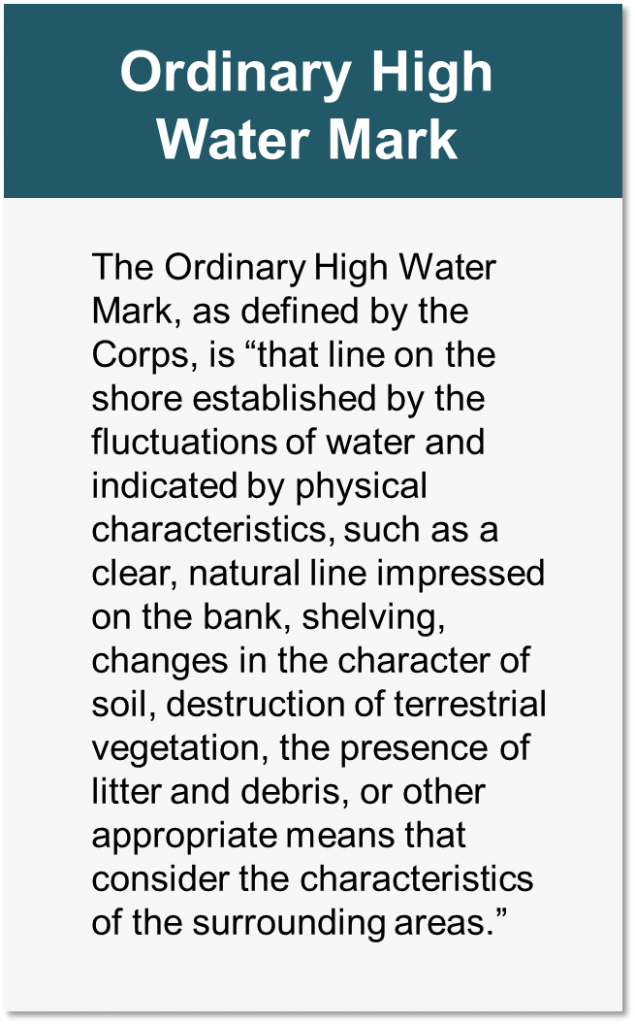 The proposed rule designates all tributaries, not otherwise excluded, as jurisdictional if they have an Ordinary High Water Mark connecting them to a traditional water of the U.S. This makes the proposed definition of a tributary very broad, with the potential for stormwater conveyance facilities, treatment wetlands, and infiltration projects to be considered Waters of the U.S. Ponds and wetlands, including both those that are natural and man-made, also could be considered tributaries.
The proposed rule designates all tributaries, not otherwise excluded, as jurisdictional if they have an Ordinary High Water Mark connecting them to a traditional water of the U.S. This makes the proposed definition of a tributary very broad, with the potential for stormwater conveyance facilities, treatment wetlands, and infiltration projects to be considered Waters of the U.S. Ponds and wetlands, including both those that are natural and man-made, also could be considered tributaries.
The issues are likely to result from interpretations of the rule. Almost certainly, there will be disagreements about defining the characteristics of a natural or man-made channel, ditch, or swale. For example, some municipal separate storm sewer system (MS4) conveyance facilities have open channels that discharge to traditional Waters of the U.S. through an outfall. Under the proposed rule, these open channels could be considered jurisdictional even though they are technically part of the MS4 and regulated under a National Pollutant Discharge Elimination System (NPDES) permit. Regulating waters under an NPDES permit and under Section 404 of the Clean Water Act would result in an unintended and unworkable regulatory outcome.
Other MS4 facilities could also be included under the proposed definition of a tributary. MS4 stormwater controls, such as wet ponds that have an “open water” component, could be interpreted as jurisdictional if connected in some way to a traditional navigable water or tributary, regardless of the distance between the two waters.
Including tributaries “by rule” is not practical when viewed from the MS4 perspective. The proposed rule should be revised to state unequivocally that the definition of tributary does not include MS4 facilities, and MS4 facilities are not a water of the US. Doing so now will save countless hours of negotiation and legal action in the future.
Waste Treatment System Exemptions Should Include Stormwater Controls
Randy Neprash, Stantec, and Seth Brown, Water Environment Federation
Within the proposed rule, an area of common interest for MS4 communities is the issue of waste treatment system exclusions in the context of stormwater management. Currently, exclusions listed in 40 CFR 122.3 specifically target discharges associated with pest control, nonpoint sources and agricultural activities, sewage and industrial wastes, water transfer activities, and even sewage discharged from vessels.
Not included here are stormwater management and treatment systems. The proposed rule plainly states that it “does not change regulatory exclusions for waste treatment systems.” There is general agreement that EPA and the Corps do not intend for traditional stormwater practices, such as detention ponds, or green infrastructure practices, such as bioretention facilities and permeable pavements, to be considered jurisdictional Waters of the U.S. However, the lack of language explicitly outlining the exclusion of these systems leaves the rule open for interpretation as to whether stormwater controls are considered jurisdictional.
To clarify that waters associated with stormwater infrastructure are not considered Waters of the U.S., many groups are suggesting that specific terms, such as “stormwater control measures” or “best management practices,” be integrated into the regulations. This would help to codify that infrastructure used to treat, manage, infiltrate, or retain urban stormwater runoff is covered under the waste system treatment exclusions. The rule also should further define the systems to which the exemption applies and could include man-made structures and devices as well as treatment measures used to improve water quality, reduce stormwater volume, control flow rate and flooding, convey stormwater, or any combination of these purposes.
The reach of an MS4 program and associated treatment systems overlap with other potentially controversial topics discussed in this article, such as the definition of tributaries and roadside ditches. In contrast, excluding stormwater controls is less controversial and has the potential to eliminate unnecessary confusion for MS4 communities and MS4 program managers.
Exemptions for Roadside Ditches Need Further Clarification
Barry Fagan, Alabama Department of Transportation
Perhaps one of the most controversial elements of the proposed rule and the most widely discussed recently is the regulation of “ditches.” Many see this topic as an expansion of federal regulatory authority and as something new. In some areas, it may well be. The truth is, water quality professionals have been avoiding, minimizing, and mitigating negative impacts to ditches as Waters of the U.S. for years.
EPA and the Corps have made a strong case that what happens in the headwaters does not stay in the headwaters. They also are well aware that too many water quality resources ― time, money, and people ― are not being fully utilized due to uncertainty, inconsistency, and inefficiencies caused by the lack of clarity in current laws and regulatory guidance.
The proposed rule potentially has the greatest effect on municipal, county, and state transportation resources. There are over four million miles of roads in the U.S. Most have ditches associated with them. The responsibility for maintaining those ditches falls largely on local governments with limited resources and existing obligations for restoring and protecting the physical, chemical, and biological integrity of the nation’s waters. But with some added clarification and consideration, the proposed rule could actually benefit transportation departments and others in the regulated community while also improving water quality.
The proposed rule is convincing in declaring ditches as tributaries, but it fails to define Ordinary High Water Mark, one of the most subjective and challenging assessments used to distinguish tributaries from other topographic irregularities. The proposed rule provides exceptions for ditches that are generally created in uplands and drain uplands, but it does not define upland. It gives specific exceptions but does not speak to the limits of those exceptions in terms of ditch length. For instance, roadside ditches often have characteristics of both perennial tributaries and of dry upland wet weather ditches along their sometimes very long lengths. The proposed rule promotes protection of water quality and addresses ditches, but it does not mention green infrastructure. Ditches that treat runoff are elements of green infrastructure.
As the sector continues to pursue its national water quality goals, more clarity and expanded exemptions for municipal and roadside conveyances ― with less than perennial flow ― and exemptions for green infrastructure would certainly make sense.
Adjacent Waters Should be More Clearly Defined
Michael Bloom, R. G. Miller Engineers, Inc.
The EPA and Corps currently assert jurisdiction over adjacent waters that border or abut a jurisdictional water, an approach defined in regulatory guidance issued after the Rapanos decision. This definition provides some degree of certainty to the regulated community because the terms border and abut are well-defined and are not subject to much, if any, interpretation. The proposed rule eliminates this certainty and replaces it with a cascade of circular definitions that will be subject to both policy and technical interpretation.
The rule states that waters adjacent to jurisdictional waters are jurisdictional. However, the term adjacent is defined to mean: bordering, contiguous or neighboring. The term neighboring is then further defined to mean waters located within the riparian area or floodplain of a jurisdictional water or waters with a shallow subsurface hydrologic connection or confined surface hydrologic connection to jurisdictional waters. The terms riparian area and floodplain are also defined using the term bordering, which makes the cascade of definitions circular.
The term riparian area is vaguely defined to be an area bordering a water where surface or subsurface hydrology directly influence the ecological processes and plant and animal community structure in that area. To determine whether a water is jurisdictional under this definition, project sponsors and regulatory agencies would have to agree on not just the location of the water and on the nature of the surface and subsurface hydrology, but also whether it is directly influenced by three separate items: the ecological processes, the plant community structure, and the animal community structure.
The term floodplain does not match the definition used by the Federal Emergency Management Agency in the context of floodplain management. It is instead defined vaguely as an area bordering waters that was formed by sediment deposition … under present climatic conditions and is inundated during periods of moderate to high flows. To determine whether a water is jurisdictional under this definition, project sponsors and regulatory agencies would have to agree not only on the water’s location and whether the area was formed by sediment deposition but also whether this area is inundated during periods of moderate to high flows. Stakeholders also would have to agree on the definition of moderate flows.
Many regulated entities are concerned that the use of vaguely defined terms that rely on circular definitions and are subject to significant technical and policy interpretation will create delays and challenges. It seems likely that the proposed rule will increase, rather than shorten, the time project sponsors and regulatory agencies debate the extent of federal jurisdiction during Clean Water Act Section 404 permitting for facilities adjacent to jurisdictional waters.
Impacts on Coastal Communities
Kurt Spitzer, Florida and Southeast Stormwater Associations
If adopted as proposed, the effects of the Waters of the U.S. rulemaking will be particularly severe on coastal cities and counties as well as other areas with significant low-lying areas.
Examining both the categorical and ancillary effects of the new definitions in the rule shows a broad, very significant expansion of federal programmatic jurisdiction. Waters that become jurisdictional are subject to EPA and Corps water policies and permits, including water quality criteria, MS4 permits, Total Maximum Daily Loads, and dredge and fill programs. Once the rule is adopted, federal courts will determine its ultimate meaning, relying on the rule’s actual text. This is why it is important to focus on the words of the rule ― not extemporaneous comments made about how those words might be interpreted after adoption.
Piecing the Puzzle Together
All waters “adjacent” to currently jurisdictional waters become jurisdictional themselves under the proposed rule. This includes “neighboring” waters within the “floodplain” of jurisdictional waters. Floodplains are areas bordering coastal or inland waters that are inundated during periods of moderate to high water flows. This is the broadest possible definition of a floodplain.
The rule also adds an expansive definition of “tributary,” specifically including man-altered or man-made ponds, canals, and ditches. While there are some exemptions for ditches that are excavated in and only drain uplands and have less than perennial flow, coastal and other low-lying areas typically have very high groundwater tables. So it is common for ditches excavated even in uplands to have standing groundwater in them.
What Might This Cost?
In its economic analysis, EPA calculated a net positive impact nationwide of around $200 million, but that analysis used a very narrow assumption of “new” waters included in the rule. In contrast, studies by the Florida Stormwater Association (FSA) show that the cost of bringing ditches up to current water quality standards typically runs about $1 million per mile. More comprehensive studies found that the rule would cost between $200 million and more than $1 billion per county in areas examined.
Why Do We Care?
There is an obvious need to do more in terms of improving surface water quality in the U.S. However, in its current form, the proposed rule is so expansive that it would force local governments to divert scarce fiscal resources away from projects with a realistic chance of improvements benefiting human uses and the environment to ditches and canals that serve no purpose other than to convey floodwaters from one point to another. In fact, the rule might have the paradoxical effect of lowering water quality ― not improving it.
New Definitions Problematic for the Semi-Arid West
Wanda DeVargas and Thomas Repp, Colorado Stormwater Council
Colorado is a headwaters state, and the Colorado Stormwater Council (CSC) is dedicated to protecting the state’s water resources through the implementation of thoroughly vetted, flexible, cost effective, and regionally appropriate stormwater regulations and programs. However, while Waters of the U.S. can and should be better defined, the recently proposed rule creates uncertainty, and it potentially changes other Clean Water Act programs within Colorado’s semi-arid geographic areas.
The definitions for “tributaries” and “significant nexus” developed by EPA and the Corps in the proposed rule as well as the Corps’ recently released manual, “A Guide to Ordinary High Water Mark Delineation for Non-Perennial Streams in the Western Mountains, Valleys, and Coast Region of the United States,” will become problematic with future jurisdictional Waters of the U.S. determinations in the semi-arid west.
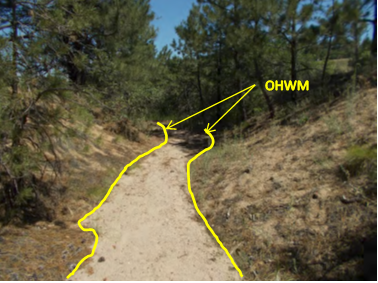
A natural drainage feature that accepts water from a roadside ditch. It has an Ordinary High Water Mark (OHWM) and is tributary to a water of the U.S. Image credit: Douglas County, Colorado
For instance, in the semi-arid west, a common feature considered to have an Ordinary High Water Mark is an ephemeral active channel, shown in the image left. The proposed rule is likely to expand jurisdiction to these channels despite the fact that they do not flow regularly and do not have a direct surface connection with or affect the integrity of downstream Waters of the U.S.
This potential expansion of Waters of the U.S. would affect both the channel’s jurisdiction and also expand the jurisdiction of all features that flow into that channel, such as roadside ditches and flood control detention facilities. Additionally, this rural feature could be considered jurisdictional if it were found to have a “significant nexus” to the local water supply, Chatfield Reservoir. Read more in Douglas County’s comments.
Conclusion
G. Tracy Mehan, George Mason University School of Law
Comments by expert practitioners in the wastewater and stormwater sectors indicate that EPA has not yet achieved its goals of certainty, predictability, and the minimizing of case-specific determinations in its quest to define Waters of the U.S. New terms introduced, very consequential ones in terms of the proposed rule’s expansion or reclamation of jurisdiction, cause great concern in the water sector. “Significant nexus,” “tributaries,” and “other waters” are abstract and open-ended and require much refinement and greater definitional clarity. The same goes for which ditches are, or are not, jurisdictional.
There is an emerging consensus that MS4s should be excluded from Waters of the U.S. status as waste treatment systems to avoid double regulation. EPA is listening. Water experts need to speak up during this important rulemaking process.
Vote
Sorry, there are no polls available at the moment.Authors’ Note
G. Tracy Mehan, III is a consultant and adjunct professor at George Mason University School of Law. He was assistant administrator for water at EPA 2001–2003.
Scott Taylor is a professional engineer in eight states. He is a senior vice president with Michael Baker International and manages the company’s Carlsbad, Calif. office.
Randy Neprash is a civil engineer and stormwater regulatory specialist who has worked for Stantec Consulting since 1994. He staffs the Minnesota Cities Stormwater Coalition, an organization of approximately 130 cites regulated under the MS4 permitting program.
Seth Brown is the stormwater program and policy director at the Water Environment Federation. Brown has 15 years of experience consulting in the stormwater sector. He is a licensed engineer in the State of Maryland and holds a B.S. and M.S. in Civil and Environmental Engineering.
Barry Fagan is the environmental program engineer for the Alabama Department of Transportation. He has more than 24 years of experience related to the construction and maintenance of roads and bridges, with more than half of that directly related to environmental protection and regulatory compliance.
Michael Bloom is the manager of the environmental engineering department of R. G. Miller Engineers, Inc. in Houston, Texas. He is a licensed engineer and an Envision Sustainability Professional with over 24 years of consulting experience.
Kurt Spitzer is president of Kurt Spitzer and Associates and a partner in Association Management Professionals. Both groups serve as the executive director of the Florida and Southeast Stormwater Associations.
Wanda DeVargas is an engineer in training with 15 years of experience in water resources and a project manager for the City of Greenwood Village, Colo. DeVargas also is the Chair for the Colorado Stormwater Council.
Thomas Repp is a licensed professional engineer and serves as stormwater management engineer for Douglas County with over 14 years of diverse water resources program and project management experiences. Repp is an active member of the Colorado Stormwater Council and conducts administrative operations for the Colorado Clean Water Coalition.

